Physical Address
304 North Cardinal St.
Dorchester Center, MA 02124
Physical Address
304 North Cardinal St.
Dorchester Center, MA 02124
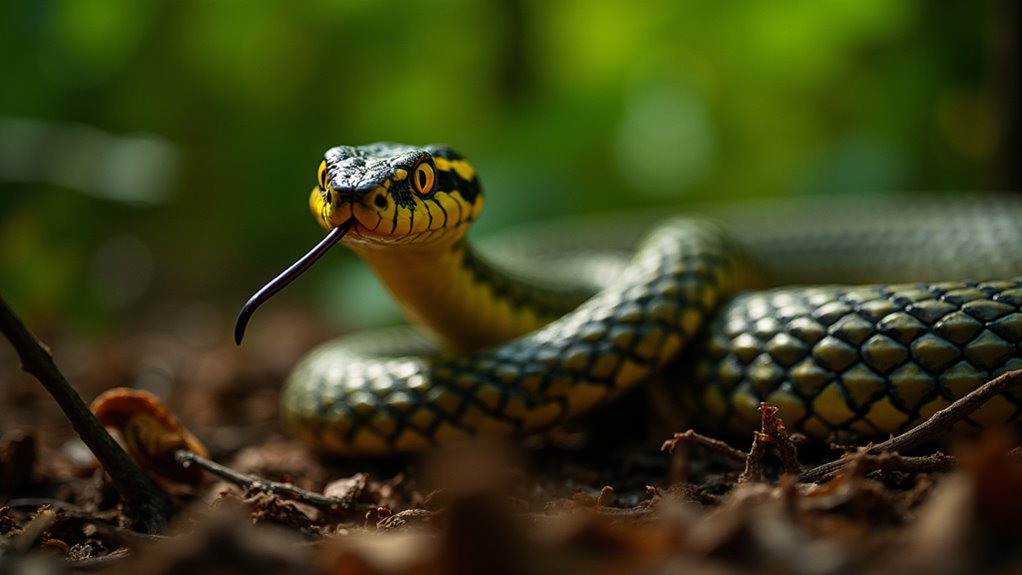
Terrifying wildlife lurks across Sri Lanka's landscapes, from deadly vipers to charging elephants – which deadly encounter could await your visit?
Sri Lanka’s most dangerous animals include the deadly Russell’s Viper and Common Krait with their potent venom, aggressive Wild Elephants causing human conflicts, and both Saltwater and Mugger Crocodiles lurking in waterways. You’ll also need to watch for Sloth Bears, Red Scorpions, Indian Cobras, and the elusive Leopard. Each creature plays a crucial ecological role while posing unique threats to humans. Learn how to safely coexist with these fascinating yet formidable species.

While exploring Sri Lanka’s diverse wildlife, you’ll need to be particularly cautious of the Russell’s Viper, the country’s most lethal snake species. This highly venomous serpent, scientifically known as Daboia russelii, typically measures 30-120 cm long with distinctive brown or golden coloration featuring three rows of ovoid spots.
You’ll likely encounter these deadly predators in open grasslands, scrub jungles, farmlands, and even urban areas where rodents thrive. They’re active hunters that employ ambush tactics, striking with potent hemotoxic venom that causes severe pain, swelling, and potentially life-threatening conditions. When threatened, they form distinctive S-shaped loops while producing loud hissing sounds before striking.
Don’t venture into their territory without proper footwear and a flashlight at night.
Though they generally avoid dense forests and high-altitude regions above 3000m, their presence in agricultural and populated areas makes them a significant threat to humans.
Unlike the slithering dangers of Russell’s Viper, Sri Lanka’s wild elephants present a different kind of threat. These majestic creatures, organized in matriarchal herds of 12-20 individuals, may appear docile but can become deadly when threatened or protecting their young.
With their population dwindling from 19,500 in the early 19th century to just 2,100-3,000 today, human-elephant conflict has intensified as agricultural expansion shrinks their habitat. These gentle giants are particularly attracted to agricultural crops like sugar cane and bananas, which frequently leads to dangerous confrontations with farmers.
You’ll find them primarily in the drier regions of south-west Sri Lanka, especially in national parks like Udawalawe and Minneriya.
Male elephants, which leave their natal herds upon maturity, can be particularly unpredictable.
If you encounter a wild elephant, maintain a safe distance and never position yourself between a mother and her calf.
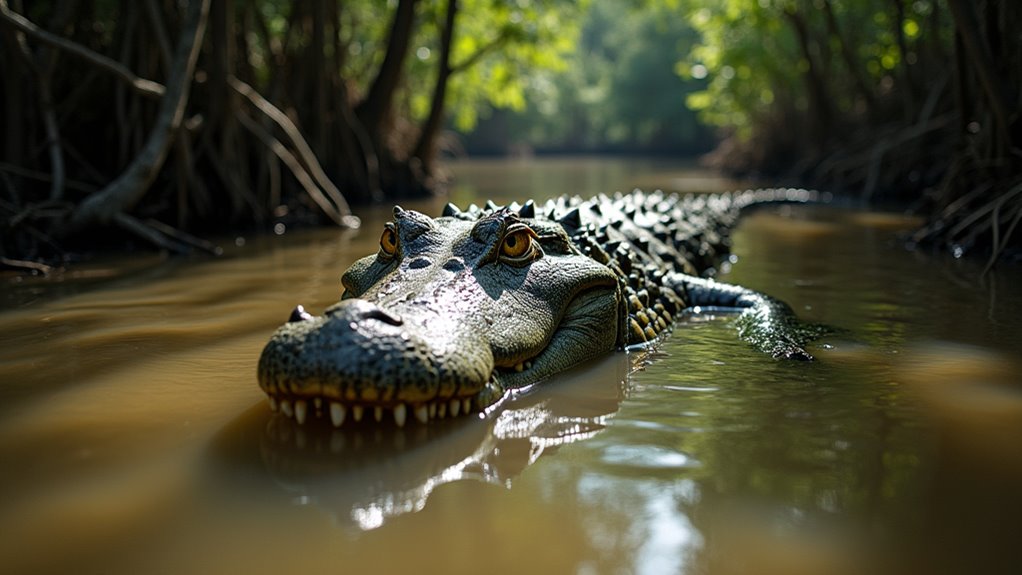
Sri Lanka’s saltwater crocodile stands as one of the most formidable apex predators in the country’s coastal ecosystems. These massive reptiles—the largest living reptile species—patrol coastal regions, estuaries, and riverine systems along the south, west, and eastern coasts.
You’ll find these territorial giants in mangrove marshlands, swamps, and occasionally in urban waterways of Colombo and Dehiwala-Mount Lavinia. Their specialized glands allow them to thrive in both fresh and saltwater environments. Known locally as Hela kimbula, these predators are distinguished by their elongated snouts and brassy yellow coloration with black blotches.
Human-crocodile conflicts occur frequently, particularly with fishermen. Wildlife authorities actively relocate “man-eating” specimens from populated areas to national parks like Bundala and Yala.
When exploring Sri Lanka’s waterways, remain vigilant—these ancient predators can travel long distances between river systems and have been involved in attacks on campers and boat operators.
Among Sri Lanka’s deadly snake species, the Common Krait distinguishes itself as one of the most dangerous nocturnal predators on the island. You’ll find this slender, dark brown snake with lighter bands in various habitats—from grasslands to human settlements and near water sources.
What makes the Krait particularly threatening is its highly toxic venom that can cause respiratory failure and death. While you’re unlikely to encounter them during daylight hours, they become active at night when they may enter homes seeking shelter. The Common Krait is endemic to Sri Lanka and primarily inhabits the wet zone region of the island.
They often hide in termite mounds, rat burrows, or under debris. If you’re bitten, seek immediate medical attention—there’s no time to waste.
Despite their danger to humans, these snake-eating predators play an important ecological role by controlling other snake populations.
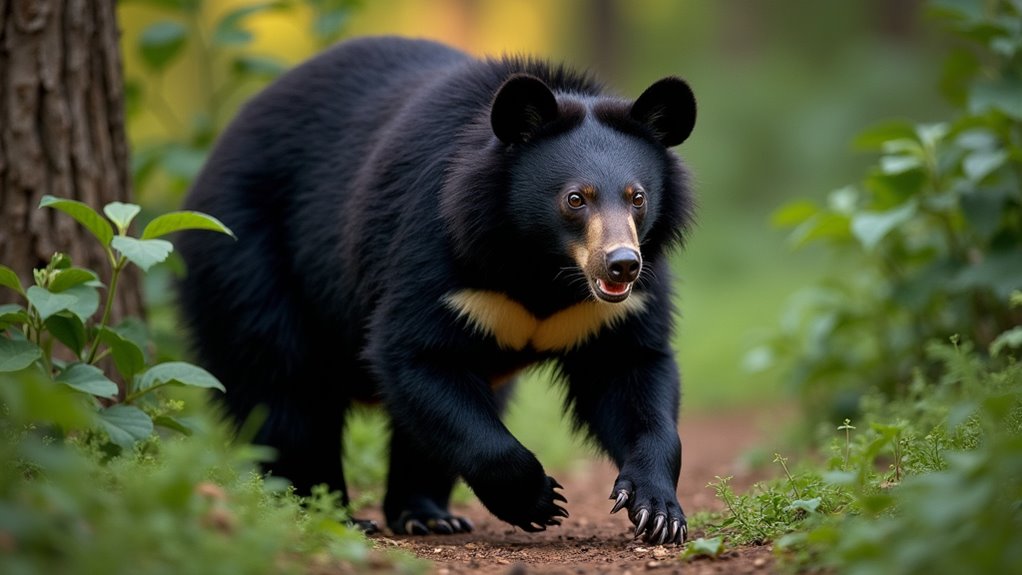
Despite their deceptively cuddly appearance, sloth bears rank among the most aggressive and unpredictable animals you’ll encounter in Sri Lanka’s forests.
These 5-6 foot creatures are identifiable by their shaggy black coat, distinctive white V-shaped chest marking, and light-colored snout.
You’ll often hear them before seeing them—they’re surprisingly noisy foragers, grunting and snorting while searching for their primary food: termites and ants.
When threatened, they’ll stand on two legs, displaying formidable claws and large canines used to defend against predators like tigers.
Don’t be fooled by their name—sloth bears aren’t slow or lazy.
They’re active throughout the day, particularly at dawn and dusk, and can quickly become dangerous when surprised or if cubs are nearby. Females are especially protective and will fiercely attack potential threats using their sharp curved claws that can reach up to 4 inches in length.
While sloth bears pose a visible threat in Sri Lanka’s forests, a much smaller yet equally dangerous predator lurks in the island’s lowlands. The Indian red scorpion (Hottentotta tamulus) has established populations in northern Sri Lanka, particularly in the Jaffna Peninsula.
Among Sri Lanka’s threats, the tiny Indian red scorpion rivals the fearsome sloth bear with its potentially fatal sting.
Don’t let its small size fool you—this bright orange-yellow to reddish-brown scorpion packs one of South Asia’s most potent venoms. If stung, you’ll experience severe pain, sweating, vomiting, and potentially life-threatening complications like pulmonary edema and cardiac arrhythmia.
You’re most likely to encounter these nocturnal hunters in rural areas where they often enter homes. The species’ introduction to Sri Lanka resulted in 12 children dying in 2011 alone, highlighting its deadly impact since arriving on the island. They’re especially active at night, sometimes falling from ceilings or hiding in bedding.
Children and the elderly face the highest risk, with stings requiring immediate medical attention.
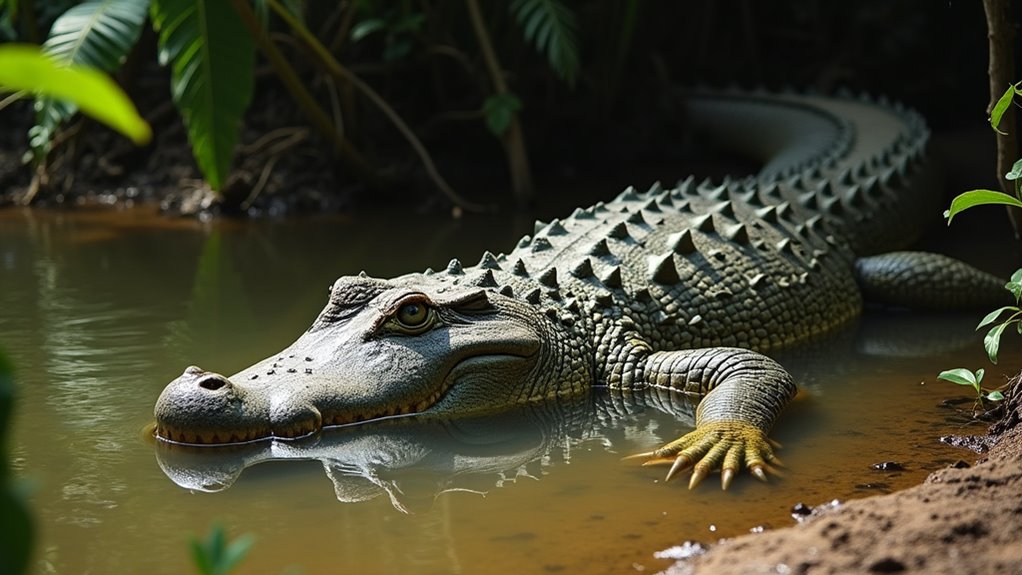
Sri Lanka’s freshwater bodies harbor one of the island’s most formidable predators—the mugger crocodile (Crocodylus palustris). You’ll find these powerful reptiles in shallow waters less than 5 meters deep, including lakes, reservoirs, and even coastal lagoons despite their freshwater preference.
Don’t be fooled by their seemingly sluggish appearance. These ambush predators can launch lightning-fast attacks from their hiding spots in murky waters.
With their robust build and broad snout, adult muggers grow up to 3-4 meters long and prey on fish, birds, and mammals. These intelligent reptiles have been observed using tool-based luring strategies during bird nesting seasons, placing sticks on their snouts to attract birds seeking nesting materials.
What makes them particularly dangerous is their mobility on land—they can pursue prey for short distances and undertake long treks between water bodies.
Their burrowing behavior and adaptability to human-altered environments mean you might encounter them in unexpected places.
No less dangerous than the mugger crocodile but far more iconic is the Indian cobra (Naja naja), one of the most recognizable serpents in South Asia. You’ll find this deadly snake throughout Sri Lanka, particularly in lowland and agricultural areas, even near human settlements.
When threatened, it’ll rear up, spread its distinctive hood marked with spectacle patterns, and hiss before striking. The cobra’s potent neurotoxic venom causes paralysis and respiratory failure, making it a significant contributor to snakebite fatalities across the region. Victims may experience symptoms within 15 minutes to 2 hours after being bitten.
Growing up to 2.2 meters long, these primarily diurnal predators seek shelter in hollow trees, termite mounds, and abandoned burrows.
Despite their danger, they play a crucial role in controlling rodent populations. If you encounter one, back away slowly—they can strike up to a third of their body length.
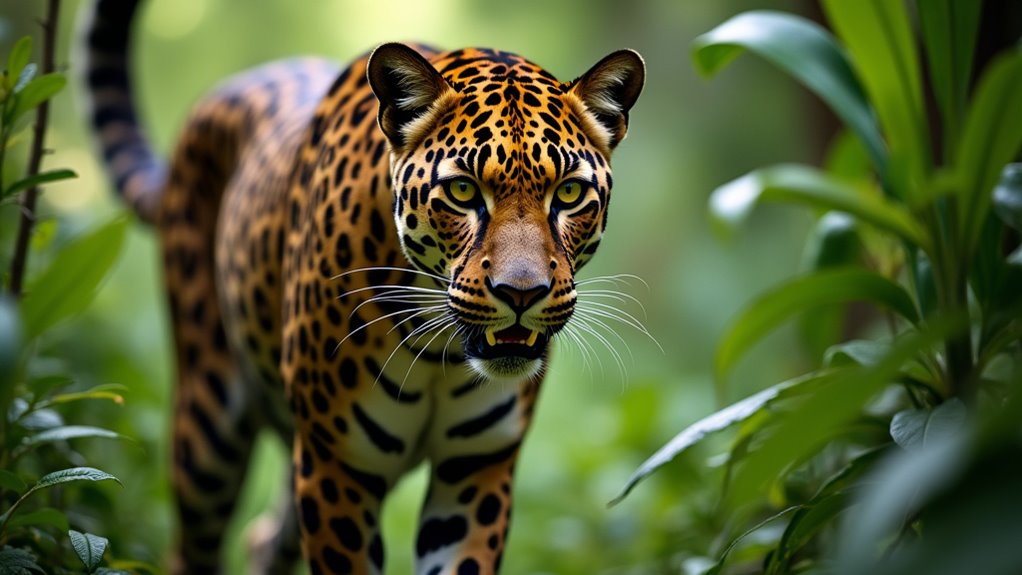
The Sri Lankan leopard (Panthera pardus kotiya) stands as the island’s undisputed apex predator, with fewer than 1,000 individuals remaining in the wild. These adaptable cats roam everywhere from sea-level scrublands to misty mountain forests, playing a vital role in controlling wild ungulate populations.
While leopards typically avoid humans, encounters can prove dangerous. They’re incredibly powerful hunters, using stealth and agility to take down prey ranging from deer and wild boar to monkeys and birds. The leopard silently stalks its prey before delivering a single throat bite to dispatch it quickly.
Their remarkable adaptability allows them to survive even in plantations and areas near human settlements.
Despite being reclassified from Endangered to Vulnerable on the IUCN Red List, they face serious threats from habitat fragmentation, poaching for body parts, and retaliatory killings when they prey on livestock.
Sri Lanka’s wild side isn’t for the faint of heart. You’ll encounter animals that can kill you in seconds or crush you without effort. From the Russell’s Viper’s lightning-fast strike to the elephant’s earth-shaking charge, danger lurks in every habitat. When exploring this paradise, remember: these creatures don’t care about your vacation plans. Stay informed, keep your distance, and you’ll return home with thrilling stories instead of hospital bills.